Going Underground, Part 2
Last week, I introduced you to the Exploratory and Vision Design teams for The Lost Caverns of Ixalan. I then started to tell you the story of its design and showed off a new card from the set. Today, I'm basically doing more of the same. I'll introduce you to the Set Design team, continue telling the story of the set's design, and show off another new card. Let's dig in!
We'll begin by introducing the various designers from the Set Design team. As always, I'm going to let the design lead introduce their team, in this case Jules Robins (who co-led the set design with Erik Lauer).
-
Click here to meet the Set Design team
-
Jules Robins (co-lead) – I've jumped all around the design process in my time working on Magic. I've worked on exploratory design, vision design, Future Future League (FFL), cube design, Commander design, booster set design, and more. I've even worked on different games produced here at Wizards of the Coast. These days, I focus on set design for booster sets, most recently leading part of the set design for Streets of New Capenna, but my vision design and exploratory design experience paid off for The Lost Caverns of Ixalan. After changing the plane for the set and being unable to get the original marquee craft mechanic to a place we could confidently execute on, we had to reconsider the mechanical basis for the entire set and ran a miniature exploratory design step again.
Erik Lauer (co-lead) – After serving on the Vision Design team, Erik led the initial section of set design for The Lost Caverns of Ixalan. He's among Magic's most experienced designers, has led numerous teams, and pioneered a lot of our philosophies and processes, like using multicolor uncommons as signposts to help players find draft archetypes. When Erik took the reins, this underground world set wasn't even on Ixalan yet. He focused the first portion of set design on trying to get the original vision design mechanical suite playing smoothly, the hardest nut to crack being a craft mechanic using multiple kinds of artifact tokens as materials.
Ethan Fleischer – Ethan was the winner of Great Designer Search 2 and has been living up to the title ever since. He's led numerous sets, including the Commander decks for Warhammer 40,000, March of the Machine, and The Lord of the Rings: Tales of Middle-earth™. Ethan is a master of capturing top-down concepts in simple designs, a big fan of underground exploration and craft games, and a wide-ranging devourer of lore, including Mayan creation myth. Consequently, he spent a lot of time early in the process mapping out which trope spaces in those veins we ought to mine.
Reggie Valk – Reggie is a Magic omnivore. He plays an array of formats and weighs in on several set designs. He also loves to capture charming concepts in card form, which he's done time and again working on Jumpstart. He leveraged that expertise to help us make playtest decks for themes with great speed, and once we realized we should return to Ixalan, Reggie dug into which parts of the original setting would be most satisfying to reprise.
Corey Bowen – Corey's come a long way since starting out as an intern in 2017. These days, he leads numerous Commander deck designs and the occasional booster set. When we concluded that we weren't going to be able to get the original vision design craft scheme to work out satisfyingly, Corey was instrumental in figuring out the essential elements for a mechanic to capture the feeling of craft and explored a lot of potential directions to do so. Corey also came up with the scheme for this set's Gods, which come back as lands when they die and give you a quest to reawaken them.
Daniel Xu – Daniel was brand new to Wizards when he joined the team for The Lost Caverns of Ixalan but immediately hit the ground running, cranking out a lot of card designs to rapidly test new mechanics as we revised the set's mechanical suite and pitching many of the set's coolest rares and mythic rares as the team went on. He offers incisive commentary on play patterns from numerous angles, and you can expect to see a lot more awesome stuff with his fingerprints on it soon.
Adam Prosak – Adam's worked on a lot of Magic over the years, from competitive format development to preconstructed deck building and leading booster sets (most recently Phyrexia: All Will Be One). He brings strong intuitions about how mechanics and themes will mesh into cohesive sets and where issues might arise under competitive pressures. Both of those skills were important to letting us rapidly churn through mechanic candidates as we revised the set's mechanical suite, and again in picking out the right ways to execute our themes once we solidified a set of them.
Andrew Brown – Andrew leads our competitive play design efforts and spends a lot of time thinking about how we can make the best Limited and Standard environments set after set, all while keeping the experiences of less-enfranchised players front of mind. He's driven a lot of improvements to how we approach competitive balance and is dipping his toes into leading set design with the upcoming Murders at Karlov Manor. He focused a lot of his efforts on this set carving out the most promising spaces to aim cards at fun Standard gameplay or creating awesome dreams for players to pursue.
Ben Weitz – Ben works in competitive play design, improving the Limited and Standard environments for every set. In addition to serving for the entirety of The Lost Caverns of Ixalan's set design, this was his first time leading the final Limited design for a set. He was final arbiter of decisions for Draft and Sealed, driving goals for ways to improve the formats' play and doing a ton of work to make individual cards the most fun they could be. On top of that, Ben did a ton to inform our early revisions to the mechanical suite, design awesome cards for Constructed applications, and chart courses for Standard decks around the set's themes.
Jadine Klomparens – Jadine drives the FFL and our work to build Standard environments, often working on Set Design teams to prepare them for smooth entry into competitive play design testing. On this set, she not only offered essential guidance on roles that cards could fill for Standard but also helped find the right shapes for a lot of individual lovable cards and identified tons of improvements to be made for the set's Limited play.
Dig It
Last week, I told the story of how the craft mechanic was designed. This week, I'm going to start our story shortly after the vision design handoff, when the Creative team had a big ask. The plan during all of vision design had been for this to be on a new plane. Early on, we'd talked about an underground world being set on a plane we already knew but decided against it. After months of tackling all the needs of building the plane, the Creative team realized they were edging closer and closer to a plane that was basically Ixalan. They spent a lot of time trying to avoid Ixalan, to give the set its own plane, but realized that they were making choices they didn't want to make. They realized that the best version of an underground world would be on Ixalan.
There were a couple issues with doing that. One, the Exploratory and Vision Design teams had spent their six months trying to craft something brand new. Two, the original Ixalan block had a setting that was much beloved, but its mechanics didn't get very high marks from the public in our market research. Could the underground set be on Ixalan without the set being a "return to Ixalan"?
War of the Spark had been the first of what we called a "backdrop" set. That is, it took place on the plane of Ravnica while not mechanically being about Ravnica. It wasn't a faction set based around the guilds. To do that, we first used the two sets right before it, Guilds of Ravnica and Ravnica Allegiance, as returns to Ravnica, complete with all the factioning that players loved about the plane. But could we do a "backdrop" set where we don't give the players a mechanical return?
Ravnica is one of the most beloved planes we've ever done, mechanically and creatively. Ixalan was much beloved creatively but fell short mechanically. If ever there was a plane that wanted a backdrop set without a mechanical return, Ixalan was it. The question for Set Design: how much mechanically do we have to do to make the set feel like Ixalan without redoing what we did on our first trip to Ixalan?
First, they looked back at all the mechanics from the Ixalan block (Ixalan and Rivals of Ixalan):
- Ascend/City's Blessing
- Explore
- Enrage
- Raid
- Transforming double-faced cards (with lands on the back face)
- Treasure tokens
- Typal themes (Dinosaur, Merfolk, Pirate, and Vampire)
We wanted to bring back a little bit to make it feel like Ixalan but not too much, as we weren't repeating the mechanical identity. Here was the thought on each mechanic:
Ascend/City's Blessing – Ascend was not super popular and requires significant structural support; not a great choice for the light touch we wanted. Also, it was awkward to have a mechanic called ascend when the whole set was about going underground. (The fact that the set had descend—which I'll talk about soon—to contrast with ascend was considered a cool nod.)
Explore – The flavor of the word was spot on, and the mechanic is both useful and well liked. A good candidate for our return.
Enrage – This mechanic was a faction mechanic tied to Dinosaurs. It also has limited design space, as the effects must be relevant mid-combat.
Raid – This mechanic was used in Ixalan as a faction mechanic for Pirates (it was first a faction mechanic for Mardu in Khans of Tarkir). It requires less structural support than enrage and has more design space. It also was fine flavorfully but didn't quite hit the vibe of the rest of the set.
Transforming double-faced cards (with lands on the back face) – Transforming double-faced cards (TDFCs) were the highest-rated mechanic in Ixalan block, and the element the Set Design team was most eager to bring back.
Treasure artifact tokens – Introduced in Ixalan, Treasure artifact tokens have gone on to be deciduous (and close to evergreen), so we got to include these for free.
Typal themes (Dinosaur, Merfolk, Pirate, and Vampire) – This was the loudest mechanical theme in Ixalan block, and the one that failed the most in execution. Set Design decided that all four creature types would exist in volume in the set but that we would pull way back on typal cards. The one exception made was for Dinosaurs. It was the most popular creature type in Ixalan block and the one we knew players have requested typal rewards for most, so we made it a big part of the red-green draft archetype for the set.
After this exploration, the Set Design team decided they wanted to use explore, TDFCs, Treasure tokens, and Dinosaur typal as the mechanical callbacks for Ixalan. I'm going to walk through how each of these inclusions influenced the other designs in the set.
Explore
This is a good place for me to talk about the theme of the library as a source of "digging." As I talked about last week, the Vision Design team found two areas that most captured the feel of digging—exiling cards from your graveyard and exiling or milling cards from your library.
During vision design, we made a mechanic called dig. It was an activated ability that worked in your hand to let you spend mana and discard the card to surveil 1, then draw a card. Here's an example:
Watchful Guardian
5W
Creature Giant
3/6
Vigilance
Dig 1W (1W, Discard this card: Surveil 1, then draw a card.)
Explore was a little too close to dig, so the Set Design team removed it from the file, but they still liked the idea of you searching through the top of your library to find something. Was there an existing mechanic that captured the essence of digging they were looking for? There was. Alara Reborn introduced a mechanic called cascade where you "dig" through the top of your library to find a spell of a lower mana value than the card that cascades.
Cascade had some issues. First, it had play design concerns. Deck construction could often offset the variance that was built into the mechanic. Second, the word didn't really have the right flavor for the setting. These two issues combined to convince the Set Design team to tweak cascade and make a different mechanic.
What they ended up with was discover. Here's the text:
Discover N (Exile cards from the top of your library until you exile a nonland card with mana value N or less. Cast it without paying its mana cost or put it into your hand. Put the rest on the bottom in a random order.)
I'll walk through the differences from cascade:
- Discover disconnected the mana value of the card you got from the mana value of the card used to generate the effect. The fact that those two numbers were always tied together with cascade made it hard to properly balance the card. Discover has a number that can be adjusted accordingly.
- Discover disconnecting its numeric value from the mana cost also allowed the mechanic to be a keyword action (i.e., it can be used as a verb happening whenever you want it to occur). This would allow us to do things like create cards that could discover turn over turn.
- Discover allows you to get spells that are equal to the number and not just lower. This was more of matching an intuition thing, as the number could have just been made one lower.
- Discover allows you the option to put the card in your hand if you'd rather not cast it, because say it's conditional like a counterspell.
- Discover also fixed some under-the-hood stuff (it's no longer tied to the casting of a spell), so now when you cast a permanent that enters the battlefield and discovers, you first resolve the permanent and then the discover effect. This was backwards to how cascade works, and we feel it's more intuitive.
Now that I've talked through discover, it's time to show off my card preview for today, which just so happens to use the mechanic.
-
Click here to see Chimil, the Inner Sun
-
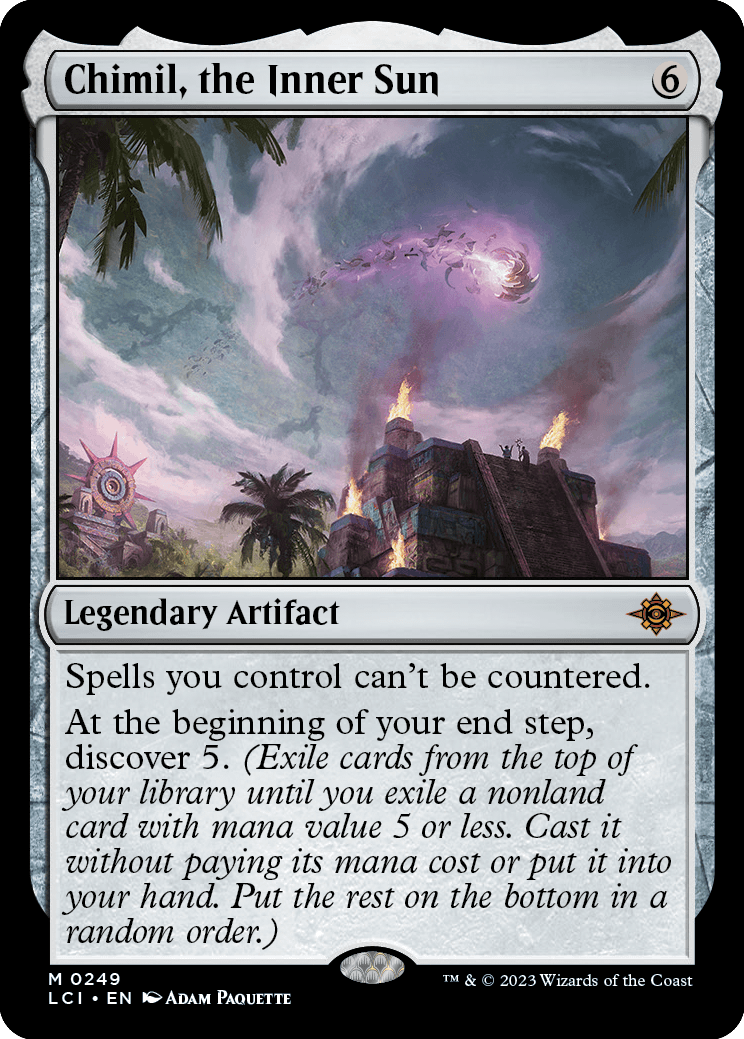
Chimil, the Inner Sun 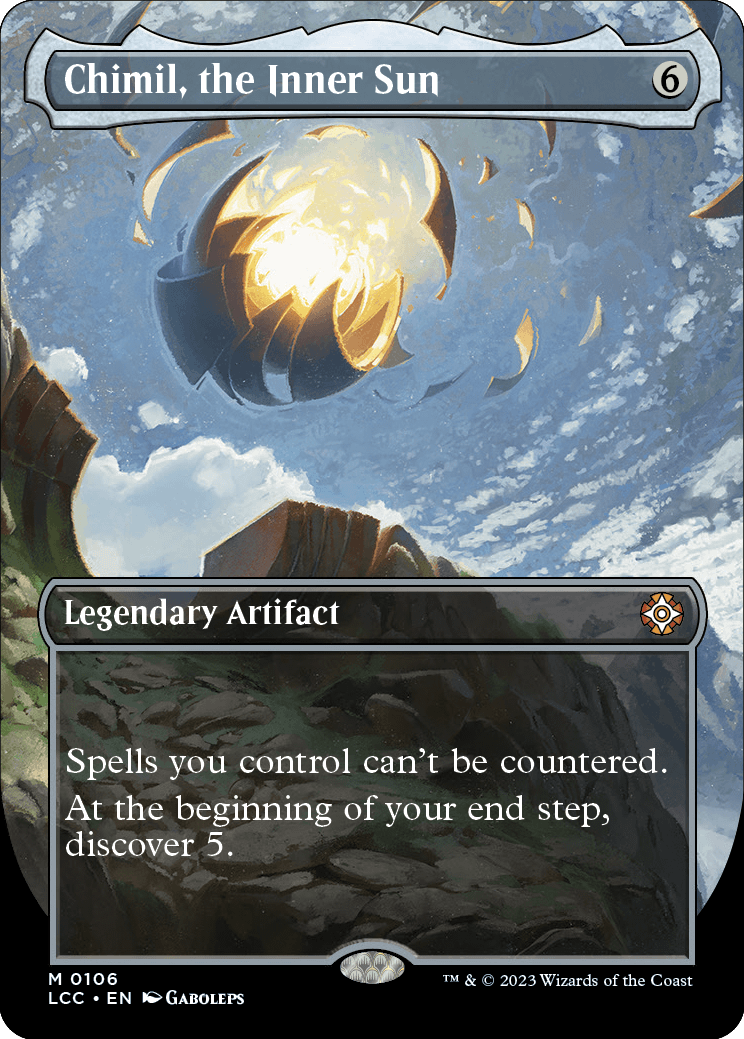
Chimil, the Inner Sun (Treasure Trove Box Topper)
Transforming Double-Faced Cards
TDFCs ended up being used in two different ways in the set: transforming into lands and craft.
Transforming into lands – In original Ixalan block, all the transforming cards had a land on the back face. The Lost Caverns of Ixalan taps into this flavor with several cards that transform into lands. Part of this group of cards is a new cycle of Gods, all of which die into lands and give you a way to transform them back into Gods. Some back-face lands have a new subtype—Cave. Cave makes use of Gate technology to add a little flavor to lands in the set and allow a few cards to mechanically care about the subset. Cave was included because it was such a flavor boon to an underground set.
Craft – The vast majority of the TDFCs with craft transform into artifacts, but some, like last week's preview card, transform into creatures. Cards with a land on the back face never use craft, and cards that craft never turn into a land.
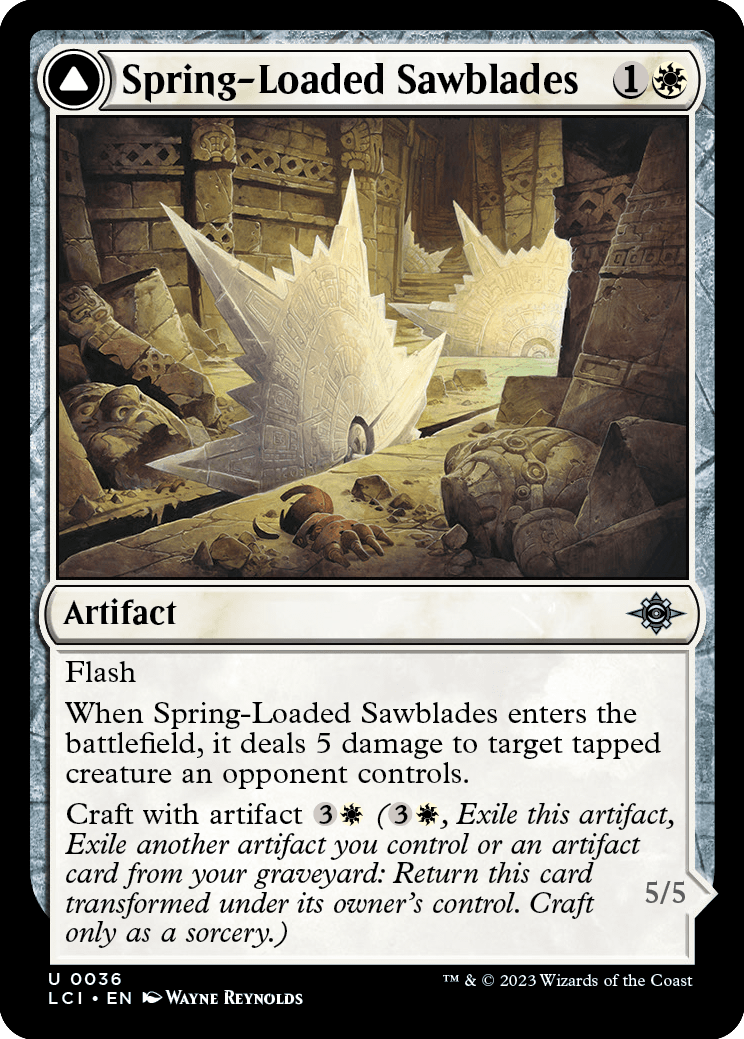
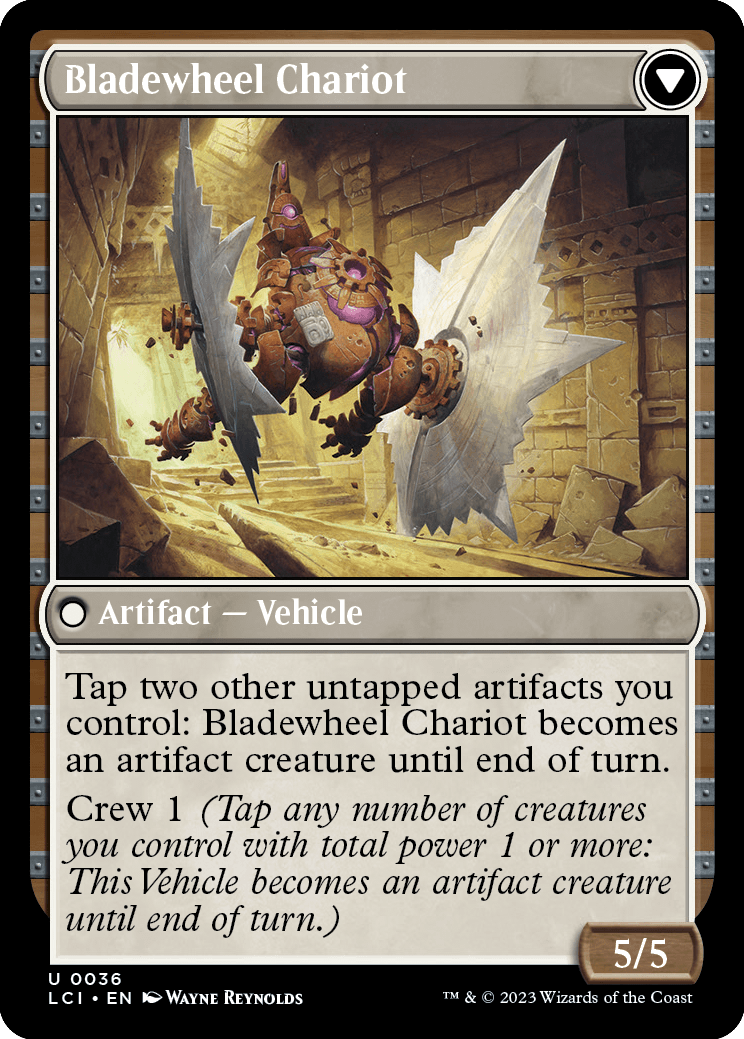
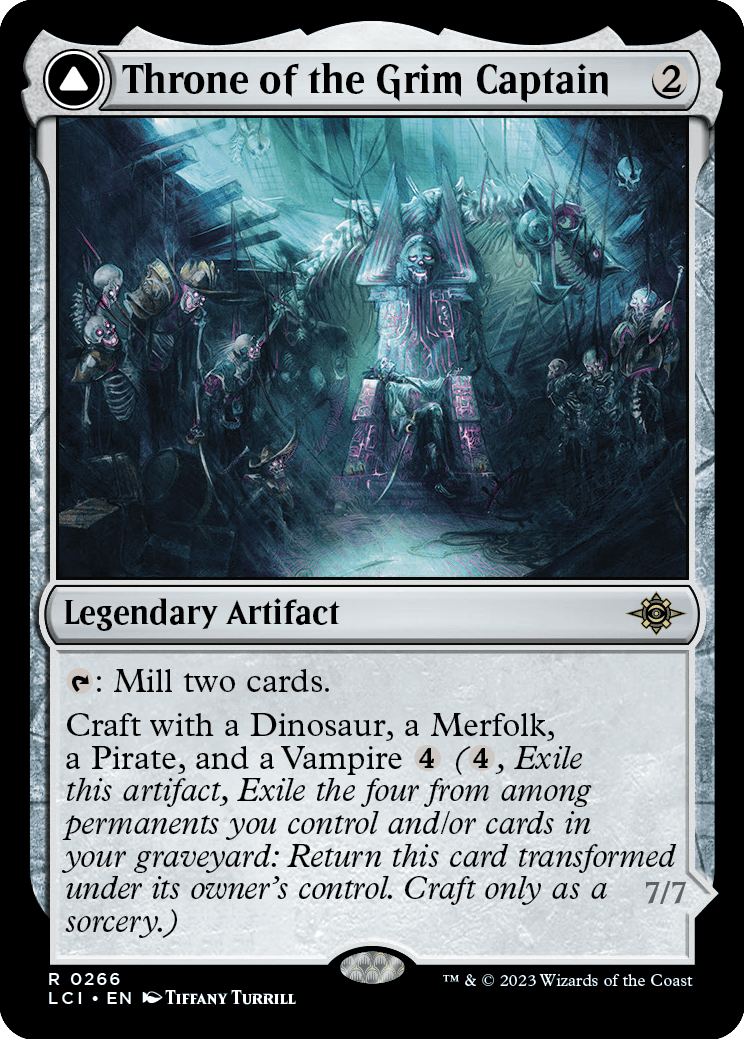
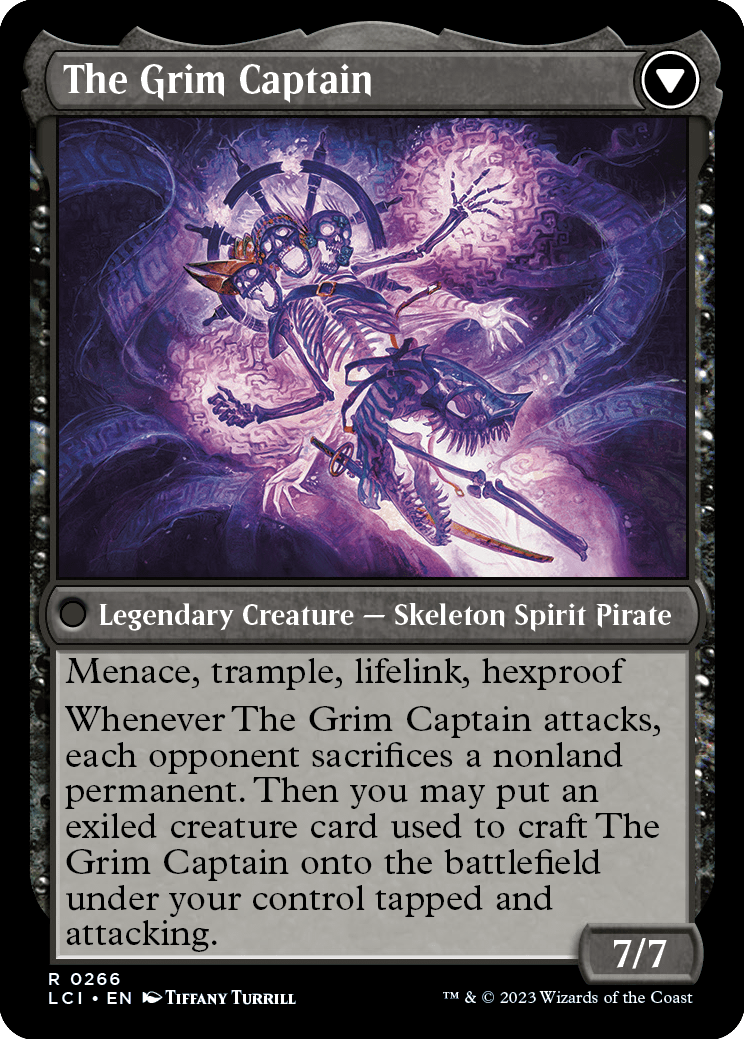
Craft makes use of the graveyard as a resource, which pushed the Set Design team to explore other ways of doing the same. The idea they were excited about was something that captured how deep you've travelled into the underground. And the graveyard, which naturally grows as the game progresses, seemed like the right zone to use.
For a while, the Set Design team experimented with caring about the number of all cards in your graveyard, a riff on threshold from Odyssey. Besides caring about how many cards were in your graveyard, they liked caring about if a card went to your graveyard this turn. Playtesting showed that instants and sorceries made the latter too easy, so in mirror to ascend from Rivals of Ixalan, which cared about the number of permanents on the battlefield, descend would care about the number of permanents in your graveyard. After much exploration and playtesting, the Set Design team found three ways to use descend:
Descend as a locked number – This is an ability word with a number used to see if you've met the threshold. For simplicity of tracking it, this type of descend only uses two numbers: descend 4 and descend 8.
Descend as a scaling effect – This is an ability word, called fathomless descent, which cares about how many permanent cards are in your graveyard. This uses a slightly different ability word, as it's something that changes over the course of the game as your graveyard grows.
Descend as an event – This is a keyword action that asks if any permanent card has gone to your graveyard this turn. Note that this can be from any zone, so both milling a permanent card or discarding it would count as descending for the turn. This execution is often used with a trigger, meaning it can happen on numerous turns.
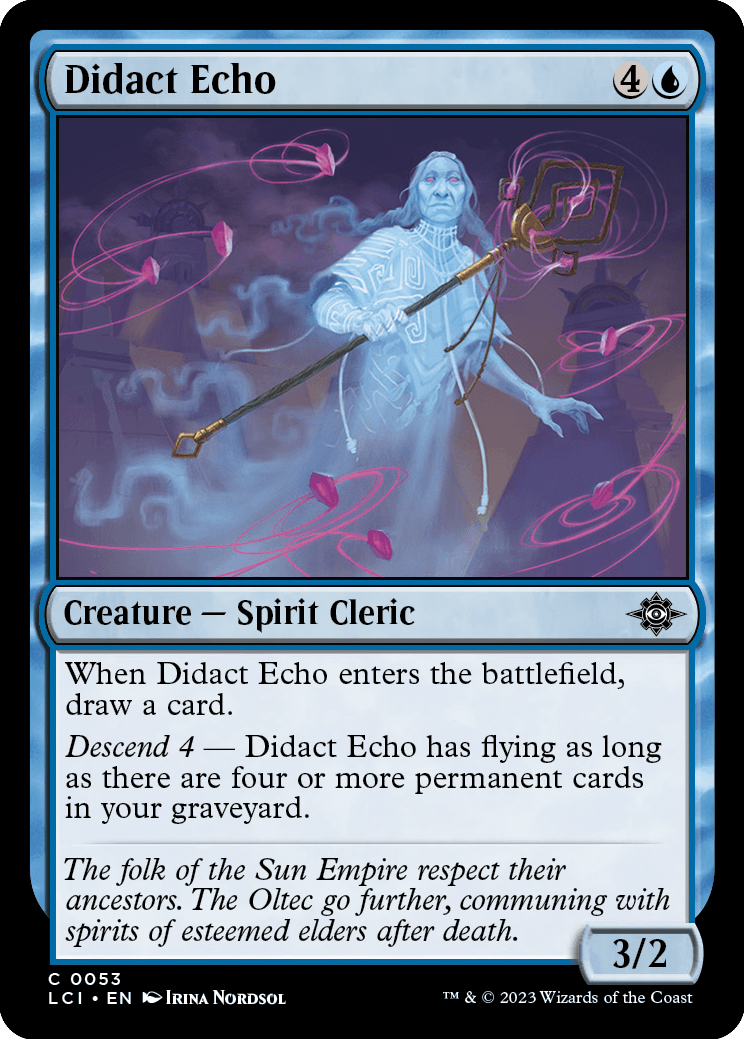
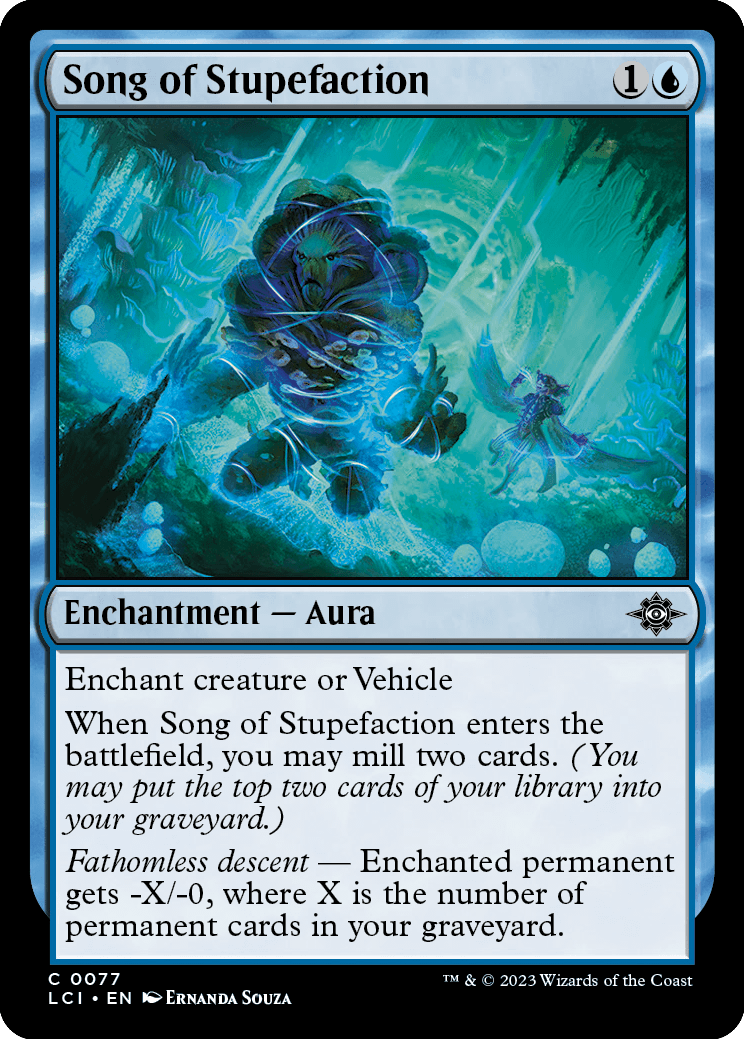
Treasure Tokens
As Treasure artifact tokens were kind of a free thing to use and had become deciduous since their premier (they're used mostly on colorless artifacts and red cards in this set), the design team felt the set could support a new artifact token. They ended up choosing to do Map tokens, partly because it allowed them to expand on using explore and partly because it was a flavor slam dunk. Maps allow you to explore for one mana and sacrificing the token.
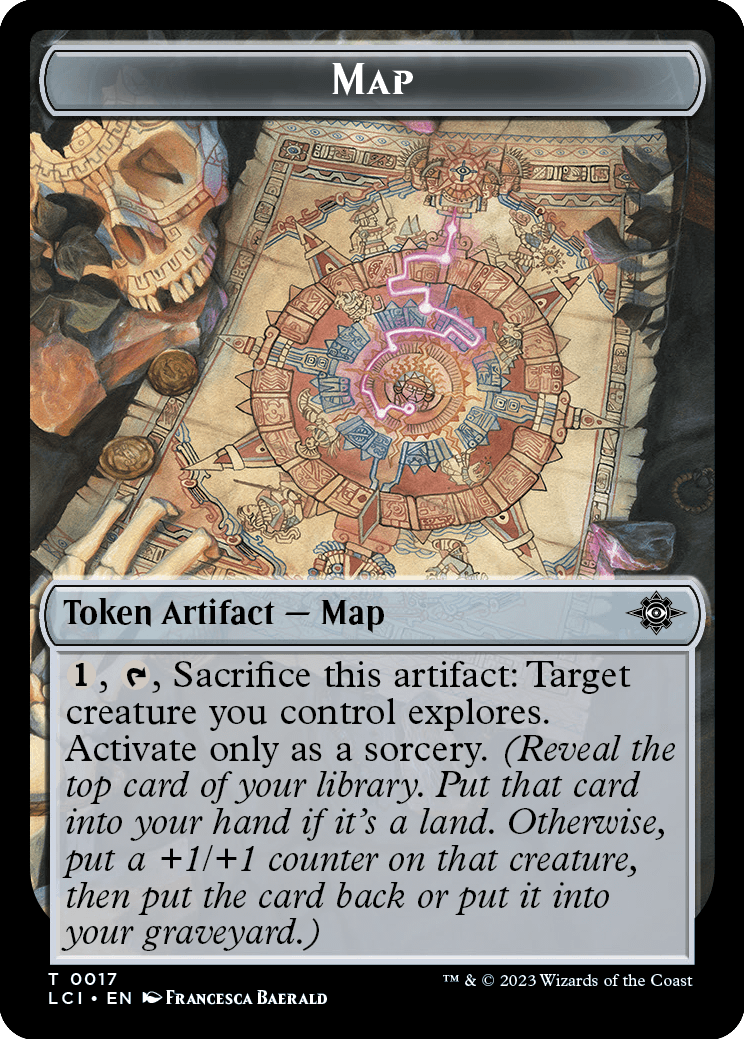
Dinosaur Typal
Dinosaur typal led to the red-green draft archetype, so this seemed like a good place to talk about them. Here's a breakdown of the ten two-color archetypes (with text borrowed from the box insert draft helpers, written by Jules):
Oltec Ingenuity (White-Blue Artifact Control): Buy time with blockers, removal, and life gain while you assemble an array of wondrous artifacts to take over the late game.
Echoes of the Dead (Blue-Black Descend Control): Set up to block while you fill your graveyard, then drag your opponent into the deep end with high-cost creatures, card draw, and recursive threats.
Going Down! (Black-Red Descending Beatdown): Keep your creatures growing by attacking viciously to make your opponent block or throwing permanents into the graveyard yourself. Then keep them down with creature removal.
Dinosaurs of the Sun Empire (Red-Green Dinosaur Stompy): Summon gigantic Dinosaurs to crush the opposition, supporting them with ways to make more mana or break through blockers.
Malamet Tactics (Green-White Buffs Aggro): Keep the pressure on with low-cost creatures. When your opponent tries to set up a defense, it's time to pounce by powering up your forces.
Dusk Legion Pilgrimage (White-Black Sacrifice): Sacrifice little creatures and artifacts for the glory of Aclazotz (and additional resources). Once you smell blood, seal their fate with a few larger creatures.
Pirates' Plunder (Blue-Red Artifact Aggro): Set sail with a rowdy crew and their haul of Equipment and Treasure. When those landlubbers try to stop you, fly over the top or throw their blockers overboard.
Fungal Festering (Black-Green Descend Grindy): Muck up the battlefield with sticky creatures while you fill your graveyard. Once you've descended enough to power your side up, start grinding your way through the opposing blockers.
Thousand-Moon Legion (Red-White Tapping Midrange): Launch your military campaign with lots of small creatures and artifacts, then tactically tap those resources to activate your forces and rout the invaders.
River Herald Expedition (Green-Blue Explore Midrange): Go exploring to stock your side with lands and powerful creatures, then sink your extra mana into activated abilities and card draw to drown the opposition in value.
Time to Explore
That wraps up today's column. I hope you enjoyed learning about how the set came to be. If you have any feedback on today's article, any of the mechanics I've talked about, or The Lost Caverns of Ixalan itself, feel free to email me or contact me through any of my social media accounts (X [formerly Twitter], Tumblr, Instagram, and TikTok).
Join me next week for a look at The Lost Caverns of Ixalan vision design handoff document.
Until then, may you dig down deep and see what treasures you can find from The Lost Caverns of Ixalan.

